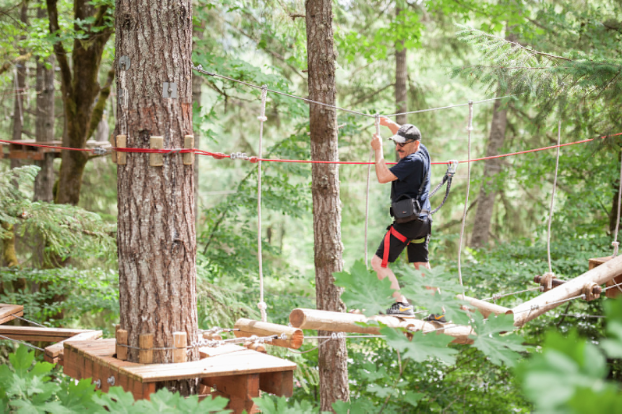An aerial obstacle course offers a unique and exhilarating way to boost physical fitness. Whether you’re seeking a fun challenge or a serious workout, these courses engage a variety of muscles, improve coordination, and test your mental resilience. By combining fun with fitness, an aerial obstacle course becomes an engaging tool to enhance your physical skills in ways traditional exercises may not.
What is an Aerial Obstacle Course?
An Aerial obstacle course typically consists of a series of suspended obstacles such as ropes, platforms, zip lines, and balance beams. These obstacles are elevated, often ranging from just a few feet to higher levels, requiring participants to navigate through them by climbing, swinging, or balancing. Designed for both beginners and advanced fitness enthusiasts, these courses can be found in outdoor adventure parks, gyms, and team-building centers.
Enhancing Physical Strength
One of the most noticeable benefits of an aerial obstacle course is the development of full-body strength. Navigating through obstacles like rope ladders, hanging rings, or swinging logs forces participants to rely on their upper body, core, and lower body. As you pull yourself across ropes or climb vertical platforms, muscles in the arms, shoulders, and back are engaged, promoting greater muscle tone and endurance.
Equally important, the lower body benefits from balancing and jumping on various platforms. Working to stabilize your body as you swing between obstacles engages the legs and core muscles, leading to improved overall strength. Regular participation can help develop functional strength that transfers well into everyday activities.
Improving Balance and Coordination
Balance is a crucial element when maneuvering through an aerial obstacle course. The elevated nature of many obstacles requires a refined sense of coordination as you work to stay steady on narrow beams or make smooth transitions between platforms. Maintaining balance on a high rope or tightrope walk challenges the body’s ability to stabilize itself, improving proprioception—the awareness of your body in space.
As your balance improves, so does your overall coordination. The combination of strength, agility, and spatial awareness required to navigate an aerial obstacle course leads to faster reflexes and more fluid body movements. These enhancements in balance and coordination can be beneficial in everyday activities, sports, and other physical challenges.
Cardiovascular Benefits
Though it may not be immediately obvious, an aerial obstacle course provides a great cardiovascular workout. The intense focus and physical effort required to conquer various obstacles elevate the heart rate, offering an effective aerobic workout. The intermittent bursts of energy to swing across platforms or climb obstacles improve heart health, endurance, and stamina over time.
Additionally, since these courses often involve timed challenges or races, participants are pushed to perform at their best, promoting improved cardiovascular fitness. As with any cardiovascular exercise, the consistency of participation is key to achieving long-term benefits.
Mental Toughness and Problem-Solving
Beyond the physical benefits, an aerial obstacle course can greatly improve mental strength. The mental challenges involved in completing each obstacle—whether it’s overcoming a fear of heights or pushing through exhaustion—are invaluable in developing resilience. Each successful obstacle completed boosts confidence and mental fortitude, encouraging participants to tackle even greater challenges.
Many aerial obstacle courses also require problem-solving and strategic thinking. You need to assess how to approach each obstacle, decide whether to go faster or take a more cautious route, and find ways to overcome any unexpected difficulties. These mental aspects can translate to enhanced decision-making skills, focus, and perseverance in everyday life.
Social and Emotional Benefits
An aerial obstacle course also has social and emotional benefits. Participating with friends or as part of a team can improve motivation and create a sense of camaraderie. Working together to tackle obstacles fosters a sense of community and shared achievement. The challenge of completing the course can also be an emotional boost, as it instills a sense of pride and accomplishment upon finishing each stage.
Conclusion
From its physical strength-building potential to its ability to enhance balance, coordination, and cardiovascular health, an aerial obstacle course is more than just a fun activity—it’s a holistic fitness experience. Whether you’re looking to improve your overall fitness or simply have fun while challenging yourself, the benefits of an aerial obstacle course extend far beyond the physical. Engaging your body and mind in this thrilling environment fosters not only greater physical capabilities but also mental resilience and emotional satisfaction.

